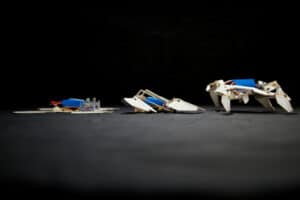
Nanotech promises more commonplace access to advanced technology as material and fabrication costs fall and traditional barriers to innovation are removed. Examples are already being seen globally: more access to laptops and cell phones in developing countries, desktop 3D printers, a surge in establishment of shared-use research facilities, etc.
A couple recent cases getting attention on GigaOm.com include the latest release of RISC-based open source chip from UC Berkeley, and self-folding ‘origami’ robots developed at the Wyss Institute and published in Science.
About the chips:
…
Fed up with the limitations of current computer chips and their related intellectual property, a team of researchers at the University of California, Berkeley, is pushing an open source alternative. The RISC-V instruction set architecture was originally developed at the university to help teach computer architecture to students, but now its creators want to push it into the mainstream to help propel emerging markets such as cloud computing and the internet of things.
One of the researchers leading the charge behind RISC-V is David Patterson, the project’s creator and also the creator of the original RISC instruction set in the 1980s. He views the issue as one centered around innovation. Popular chip architectures historically have been locked down behind strict licensing rules by companies such as Intel, ARM and IBM (although IBM has opened this up a bit for industry partners with its OpenPower foundation). Even for companies that can afford licenses, he argues, the instruction sets they receive can be complex and bloated, requiring a fair amount of effort to shape around the desired outcome.
…
But Patterson appears to be looking out for the little guy — small companies or researchers that want to develop their own chips for their own specialized applications, but don’t have deep pockets. That requires being able to experiment with the underlying instruction set, experiment with chip designs and share that work openly without fearing a violation of license terms.
…
About the robots:
…
The robots are made from paper, plastic and electronic components. Networks of circuits deliver heat created by a battery to the areas of the robot that need to fold. The plastic, which was made to transform into a preset shape when exposed to temperatures higher than 212 degrees Fahrenheit, then begins its transformation. The robots created at Harvard took about four minutes to turn into their final 3D shape.
…
The robots could also be an interesting alternative to 3D printing, according to Rob Wood, the senior author on a study about the robots that appeared in the journal Science today. He said the starting materials to build the robots are all off-the-shelf and makeable with tools like laser cutters, so they are relatively cheap. The technique is similar to 3D printing in that it is especially suited to making between 100 and 1,000 units of an object, but it’s faster. And like 3D printing, it can be used to make items at a scale far too tiny for human hands.
…
-Posted by Stephanie C

